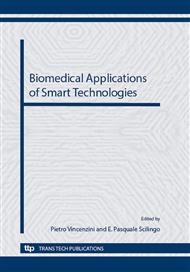[1]
D. E. Discher, P. Janmey, Y. L. Wang, Tissue cells feel and respond to the stiffness of their substrate, Science 310 (2005) 1139-1143.
DOI: 10.1126/science.1116995
Google Scholar
[2]
B. Geiger, J. P. Spatz, A. D. Bershadsky, Environmental sensing through focal adhesions, Nature Rev. 10 (2009) 21-33.
DOI: 10.1038/nrm2593
Google Scholar
[3]
B. D. Hoffman, C. Grashoff, M. A. Schwartz, Dynamic molecular processes mediate cellular mechanotransduction, Nature 475 (2011) 316-323.
DOI: 10.1038/nature10316
Google Scholar
[4]
N. Yui, R. Katoono, A. Yamashita, Functional cyclodextrin polyrotaxanes for drug delivery, Adv. Polym. Sci. 222 (2009) 55-77.
Google Scholar
[5]
N. Yui, Emerging biomedical functions through "mobile" polyrotaxanes, in: A. Harada, (ed.), Supramolecular Polymer Chemistry, Wiley-VCH, Weinheim, 2012, pp.195-204.
DOI: 10.1002/9783527639786.ch9
Google Scholar
[6]
T. Ooya, M. Eguchi, N. Yui, Supramolecular design for multivalent interaction: high mobility of maltose groups in polyrotaxanes enhanced binding with Concanavalin A, J. Am. Chem. Soc. 125 (2003) 13016-13017.
DOI: 10.1021/ja034583z
Google Scholar
[7]
T. Ooya, H. Utsunomiya, M. Eguchi, N. Yui, Rapid Binding of Concanavalin A and Maltose-Polyrotaxane Conjugates Due to Mobile Motion of a-Cyclodextrins Threaded onto a Poly(ethylene glycol), Bioconj. Chem. 16 (2005) 62-69.
DOI: 10.1021/bc049809h
Google Scholar
[8]
H. Hyun, N. Yui, Azidated polyrotaxanes for facile and efficient functionalization via click chemistry, Macromol. Rapid Commun. 32 (2011) 326-331.
DOI: 10.1002/marc.201000631
Google Scholar
[9]
H. Hyun, N. Yui, Ligand Accessibility to Receptor Binding Sites Enhanced by Movable Polyrotaxanes, Macromol. Biosci. 11 (2011) 765-771.
DOI: 10.1002/mabi.201000507
Google Scholar
[10]
Y. Inoue, L. Ye, K. Ishihara, N. Yui, Preparation and surface properties of polyrotaxane-containing tri-block copolymers as a design for dynamic biomaterials surfaces, Colloid Surf. B: Biointerface 89 (2012) 223-227.
DOI: 10.1016/j.colsurfb.2011.09.020
Google Scholar
[11]
J-. H. Seo, S. Kakinoki, Y. Inoue, T. Yamaoka, K. Ishihara, N. Yui, Designing dynamic surfaces for regulation of Biological responses, Soft Matter 8 (2012) 5477-5485.
DOI: 10.1039/c2sm25318f
Google Scholar
[12]
H. Chen, L. Yuan, W. Song, Z. Wu, D. Li, Biocompatible polymer materials: Role of protein-surface interactions, Prog. Polym. Sci. 33 (2008) 1059-1087.
DOI: 10.1016/j.progpolymsci.2008.07.006
Google Scholar
[13]
J. C. Liu, D. A. Tirrell, Cell response to RGD density in cross-linked artificial extracellular matirx protein films. Biomacromolecules 9 (2008) 2984-2988.
DOI: 10.1021/bm800469j
Google Scholar
[14]
M. Arnold, V. C. Hirschfeld-Warneken, T. Lohmuller, P. Heil, J. Blummel, E. A. Cavalcanti-Adam, M. Lopez-Garcia, P. Walther, H. Kessler, B. Geiger, J. P. Spatz, Induction of cell polarization and migration by a gradient of nanoscale variations in adhesive ligand spacing, Nano Letter 8 (2008) 2063-2069.
DOI: 10.1021/nl801483w
Google Scholar


